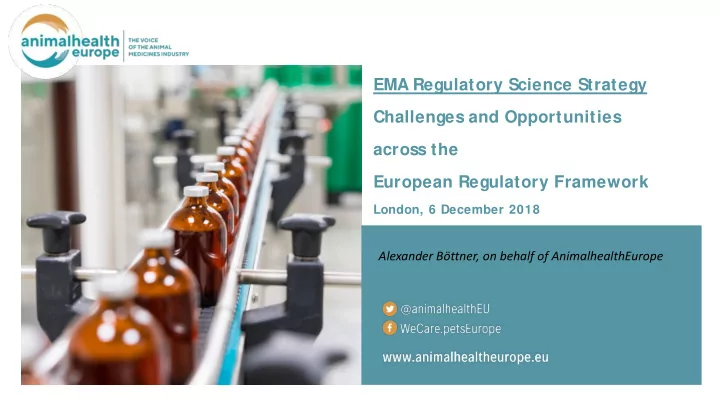

EMA Regulatory Science Strategy Challenges and Opportunities across the European Regulatory Framework London, 6 December 2018 Alexander Böttner, on behalf of AnimalhealthEurope
PAGE 2 Agenda Environment Challenges Opportunities Conclusions
PAGE 3 The Environment Regulatory environment in the EU Highly regulated framework More progress needed for risk based assessments Well functioning but resource constraints, opportunities of NVR must be utilised! Dialogue is key and should be expanded Maj or influencers & challenges: S ocio-economic and political aspects have high impact, tendency to increase! (AMR, animal production & welfare, social media, environment, climate change) Maj or driver: Economics of animal production (livestock) Common agriculture policy Pet owner growing expectations and health demands (oncology, geriatrics) Maj or constraint on innovation: S mall market size, highly fragmented (multiple spp) and cost sensitive (agri) Political/ public attitudes towards new technologies (risk aversion) Global development proj ects vs. differing country/ regions requirements
PAGE 4 The Challenges Modern production systems, socio-economic factors and environmental aspects will continue to be a maj or driver of changes in livestock production More complex animal health needs are likely to evolve from there (e.g. antimicrobial alternatives, herd health optimization, adaption to climate change, food safety) Emerging diseases require rapid responses (vaccines, novel therapies) Non proportionate regulatory constraints can halt new product developments (e.g. REACH, MRLs and excipients, ERA requirements) Regulatory uncertainty for new technologies/ innovative product developments Political attitudes and public acceptance towards new technologies (risk aversion)
PAGE 5 The Opportunities High regulatory standards should be maintained but have to become more „ suitably adapted“ Risk benefit vs. „ worst-case“ Consistent application of benefit-risk assessment Regulatory opportunities for new technologies (early dialogue, requirements) Adj ust requirements to needs (e.g. sterility test for oral vaccines, monoclonal antibodies) Enable more tailored, regulatory provisions (e.g. proof of clinical efficacy) Dialogue and co-ordinated exchange Efficient and timely co-ordinated advice with regulatory authorities More expert networking including industry expertise, global expert panels etc. New technologies, avoid the need for future regulatory convergence, alignment from the start
PAGE 6 The Opportunities (ctd.) Regulatory science will advance and will require new disciplines Epidemiology Databases and information technology experts Risk assessor vs. hazard assessor Modelling tools (in-vitro / in silico vs. in-vivo models) Vaccine readiness and availability Pre-approved versatile production platforms Accelerated regulatory approval processes (e.g. multi-strain dossiers, antigen master files) More pragmatic approach (field efficacy only when needed, serology as surrogate of efficacy, efficacy at “ herd” level)
PAGE 7 The Opportunities (ctd.) PPHOVA / S mPC harmonisation Utilize existing knowledge and act pragmaticly More expertise needed (modelling tools) Conditional licensing / limited markets and exceptional circumstances Annex II of the new veterinary regulation Fit for purpose Provisons required for new technologies and the „ unknown“ Opportunity should not be missed despite various constraints Utilize high EMA reputation and international profile for Regulatory convergence Reduction of administrative burden Coordinated exchange
PAGE 8 Conclusions Regulatory science strategy initiative is an excellent starting point to shape the future regulatory environment Today workshop must be a start for further exchanges; more work needs to be done before finalisation High, science based regulatory standards should foster innovation and medicines availability Maj or challenges and opportunities ahead Challenges can become opportunities and vice versa!
PAGE 9 Thank You
Recommend
More recommend